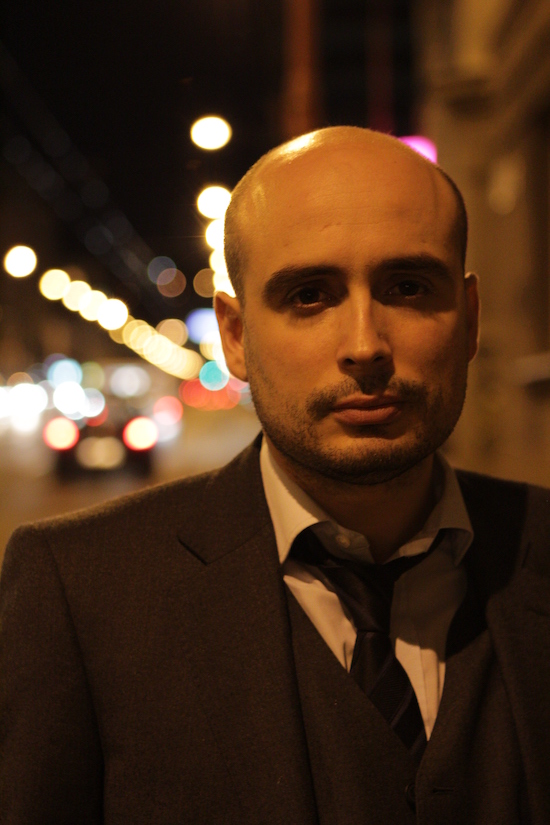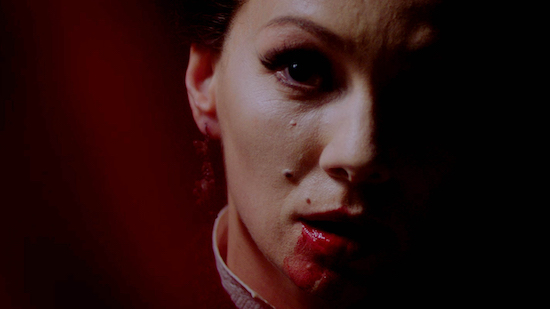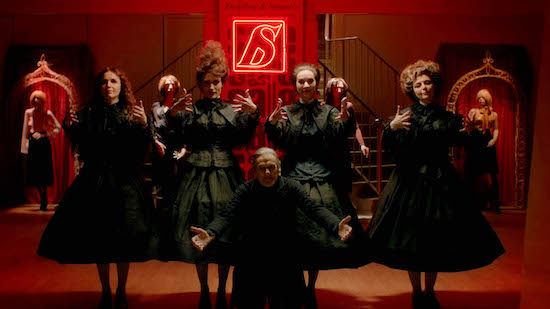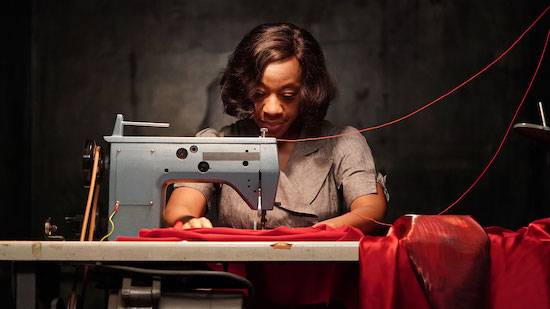In a high street department store, a woman buys a dress in the winter sales to wear on a blind date, only to discover that her purchase harbours strange occult powers. But more than a film about a cut-throat frock or the pre-internet dating scene, In Fabric is a film about work. “Work –” its director, Peter Strickland corrects me, “and clothing.”
It is true that the film likes to linger on the textures of cloth, that it works as a meditation on our lives in – and out of – fabric. “The human imprint on clothing, that’s what fascinates me,” Strickland confesses as we sit opposite each other in the subterranean meeting room of an old-school Soho hotel. He wears a tweedy blazer and a dun shirt, open at the neck, and he furrows his brow slightly as he talks to me about “looking at different ways of the association of humans with clothing, how we feel when we put clothing on, whether we feel transformed, or whether we are reminded of ourselves and our distorted body image.”
But it is reflections on work, on the micro-aggressions of service industry employment, that provide for the film much of its comedy – and a great deal of the horror. A bank teller chastised by her superiors for her handshake; a washing machine repairman disciplined for using his skills – the company’s property, after all – to repair his own machine. In one scene, we literally see the characters labouring to produce the very thing that destroys them.
Strickland himself is no stranger to the tertiary sector. In his younger days, he worked at a branch of TGI Fridays. “We used to greet the first customers coming in on a Saturday morning,” he recalls. The experience directly inspired a scene from In Fabric. “But, you know, it was not a bad job, actually. The staff were great, they took me under their wing.”
“You were forced to be happy,” he continues in his reminiscence of his former life in the casual dining industry. “But actually, it rubs off after a while – unlike this job. So, no, it was not all doom and gloom.” I am now concerned that no-one amongst the small retinue of producers and PRs that preceded Strickland to this meeting is dragooning the director into mandatory contentment. Perhaps they should be. Desire is a strange thing.

Nowhere more so than in the films of Peter Strickland. In Fabric, in particular, is a catalogue of minor kinks. Characters have hang-ups around textiles and threads of all sorts: hosiery, lingerie, taut rope against flesh, a zip-up fleece, its texture, its finish, and its touch. Fixations, also, to do with sound. “The whole film comes out of ASMR videos,” Strickland tells me, referring to the autonomous sensory meridian response which YouTube unboxing communities associate with certain especially whispery, crumbly, textural sounds. “I watched a lot of those on YouTube,” he says. “It’s very interesting for me, because I wasn’t really aware of it until quite recently.”
Over the last few years, thousands of people have amassed online to share and discuss the efficacy of videos depicting haircuts, fingernails on plastic, the scrunch of stiff paper, experiencing cascades of tingles in response. In Fabric is teeming with such sounds: creaks and scratches, the crunch of a mouthful of peanuts, the creak of wire coat hanger against its rail, the grate and screech of a dumb waiter, the sizzle of frying peppers, the droning murmur of a man carefully explaining the internal workings of a busted washing machine.
“I remember making a tape,” Strickland recalls, “like a private tape for myself. Because I used to know a radio engineer in Hungary who had access to archives from the 70s, and he had this summit from Eastern Europe with these different languages on different tracks being translated. It was like a wall of sound with Bulgarian, Russian, Polish, Hungarian. I put it through a mixing desk with different EQ and reverb on each channel. And I used to go to sleep to it. It was like an hour long. Didn’t understand a word. That was ASMR before I knew what it was.”
“In a way that was more exciting,” he continues. “Once you put a name to it, it loses its mystery. But a lot of the music I love, like Luc Ferrari, Costin Miereanu, Nurse With Wound, Robert Ashley – I always thought, why don’t I have this intellectual response like other people have to hearing this music? And somehow when hearing about ASMR, knowing what it was, it kind of validated my response. So, yeah, I guess I wanted to make an all-out ASMR film. Have characters put into a trance by this mantra.”

There is a curious temporality to In Fabric. You’re never quite sure what era you’re seeing. When we watched it together, my wife assumed the film was set in the 60s. Based almost solely on a glimpse of a VHS player, I guessed 1980s. “No, it’s ‘93,” says Strickland, setting the record straight. “But you’d have to be very eagle-eyed to see that. You’d only see it when pausing it on DVD. There’s a newspaper clipping. But as you pointed out, those stores always felt like a mixture of the 60s, 70s, 80s. They never really changed. There are not many giveaways of the 90s. The fleece jacket is the biggest giveaway.”
The specific inspiration for the shop in the film was a department store called Jackson’s. Once the proud flagship of a nationwide chain, Jackson’s once proudly bestrode the high street of Strickland’s home town of Reading. Then the branches all started closing, leaving just the original outlet in Reading, which finally went bust on Christmas Eve, 2013. “When I wrote it, I imagined it in Jackson’s. There was thick white carpet which muffled the sound of the movement of women shopping. We tried to shoot in Jackson’s but it was gone. It was very difficult to find a place to shoot in.”
In Fabric depicts a disappeared world in many respects: a vanished provincial English high street, the obsolete world of pre-internet personal ads. But a lot of the films’s peculiar sense of out-of-time-ness comes from its music, by Stereolab’s Tim Gane, under his Cavern of Anti-Matter moniker. “The best gift you can give to a musician is just to let them breath, let them have their own space,” Strickland says. Gane made a series of demo tapes for the director before he even started writing. “I need music to get me going,” Strickland explains. He would play the tapes on set during filming and many of those sounds – along with more composed by Gane later – ended up in the final film.
Strickland first came across Gane’s old groop thanks to the Scala Cinema in London’s King’s Cross. “They’d often have a film and then a band would play before or afterwards. It was 1992. I can’t remember what month. It was Stereolab, Huggy Bear, Mambo Taxi, and the film was The Bird With The Crystal Plumage. I couldn’t go.” Despite missing the gig, the event had a lasting, almost subliminal effect on Strickland. “You imagine what the music was like, you imagine what the film was like…”

Strickland was soon buying all Stereolab’s records, going to their gigs. “But it wasn’t just the band,” he says, “it was the world they created.” Through Stereolab’s Duophonic label, Strickland first encountered the music of Broadcast, of Nurse with Wound, and the visual art of Julian House, who has been “a huge part of this whole thing”, working on the poster for In Fabric as well as the title sequence and one other montage sequence in the film itself (an advert for the department store at its centre).
The films of Dario Argento, from The Bird With the Crystal Plumage onwards, have likewise proven a persistent inspiration – but one that Strickland claims is sometimes overplayed by critics. “Questions keep coming up about giallo cinema,” he says, “and obviously I’ve seen my fare share of giallo films. But weirdly it didn’t come into this film. In a way, it would be more glamorous to say, yes, this came from Bava and Argento, but actually, if I’m really honest, a lot of it came from watching The Office.” Ricky Gervais and Stephen Merchant’s early 00s sitcom set in a Stroud paper supply company “really spoke to my group of friends,” Strickland says, “who were, again, middle class, doing these data entry jobs. Most of the 90s were spent like that, dreaming of making films. But seeing it as a waste of time. In hindsight, it was not a waste of time.”
From his early days at TGI Fridays, Peter Strickland has led a storied career. Playing in The Sonic Catering Band from the late 90s, making videos for A Hawk and a Hacksaw and Flying Saucer Attack, running his own record label, Peripheral Conserve, that’s put out music by Xylitol, The Bohman Brothers, and Jean-Michel Van Schouwburg. So I’m curious why Strickland has never, like David Lynch or John Carpenter, used music of his own making in his films.
His response is demur, at first – “I’m really not very musical,” he insists, “I can play a few instruments, very very badly” – but then he says:
“Ah, watch this space!”
In Fabric, directed by Peter Strickland, is in UK cinemas now


